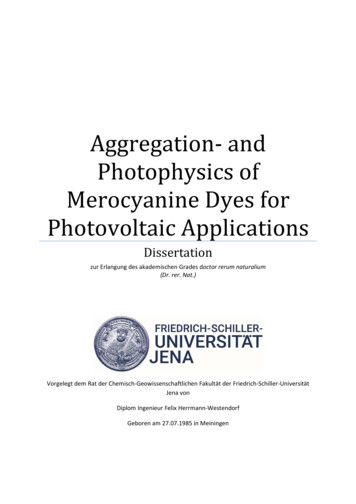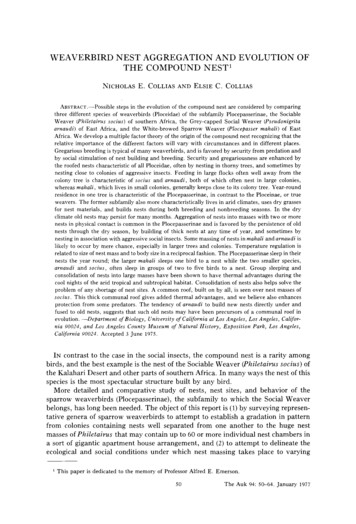
Transcription
Aggregation- andPhotophysics ofMerocyanine Dyes forPhotovoltaic ApplicationsDissertationzur Erlangung des akademischen Grades doctor rerum naturalium(Dr. rer. Nat.)Vorgelegt dem Rat der Chemisch-Geowissenschaftlichen Fakultät der Friedrich-Schiller-UniversitätJena vonDiplom Ingenieur Felix Herrmann-WestendorfGeboren am 27.07.1985 in Meiningen
Gutachter:1. Prof. Dr. Benjamin Dietzek12. Prof. Dr. Volker Deckert13.1Tag der Verteidigung:05.07.20191i
List of FiguresList of Tablesv1Introduction12Materials and Experimental Methods72.17Dyes7Additives, matrix materials and solvents72.2Thin film preparation8Drop casting and spin coating8Langmuir-Blodgett technique92.33MaterialsSpectroscopy12UV-vis Transmission12Data analysis for illumination dependent UV-vis measurements13Fluorescence Spectroscopy13Femtosecond Transient Absorption Spectroscopy172.4Aggregate characterization in solution202.5Morphological Characterization21Aggregation and Photoaggregation of Merocyanines in Solution3.1Electronic Structure of Individual Merocyanines233.2Aggregate Formation24Ground State Aggregation25Excited State Aggregation31Kinetics of Excited State Aggregation323.3Discussion on Reversibility and possible DegradationEffects of environment on the photo aggregation3.44522Conclusion of Aggregation and Photoaggregation of Merocyanines in SolutionAggregation of Merocyanine dyes in thin films343537394.1Langmuir Monolayer Characteristics at the Air-Water Interface394.2Morphologies of Thin Films404.3UV-vis Absorption of Thin Films45Photoinduced Dynamics in Solution and thin films505.1Fluorescence and Fluorescence Quantum Yields505.2Excited State Dynamics of Solution and Thin Films53Stability of the Molecules during the Transient Absorption Measurements54Transient Kinetics of D3A55ii
Transient Kinetics in Thin Solid Films Made of D3A with Different Morphology61Transient Kinetics of D4A64Transient Absorption of Thin Films made of D4A70Discussion746Summary and 7Driving forces of aggregate formation97Quantum chemically derived properties of dimers99Dynamic light scattering (DLS) experiments101SVD analysis for photoaggregation data102Kinetics106Analysis of the photo dimers107Gel formation in highly concentrated solutions110Transient absorption of D2A113Danksagung115Declaration of Originality119iii
List of FiguresList of FiguresFigure 1 Simplified overview of the Energy levels in monomers, dimers and H- and J-aggregatesdrawn like in Würthner et al.42 The LUMO of the H and J aggregates is plotted over the angle ofthe transition dipole moments (α) between two adjacent single molecules. The definition of α isillustrated in the top left corner. The straight line resembles final state of the allowed opticaltransition, while the dotted line resembles the final state of the forbidden one. Here the rangeof α were the J-aggregate is the allowed transition is colored in red, while the range of α for Haggregates is colored in blue. . 3Figure 2 Alignment of DSSC dyes on the water surface of an LB trough in comparison with apossible alignment on the TiO2 surface of a DSSC. Here D4A was used as model dye. . 4Figure 3: Lewis structures of the merocyanines D2A, D3A, D4A. The red shaded area representsthe electron acceptin moiety, the green parts are the electron bridge and the blue shaded areasare the electron donating moieties. . 8Figure 4 Schematic picture of a Wilhelmy balance. The sensitive balance consists of a longspring, where the platinum plate is attached to and a laser deflection measurement unit (Laser PSD). The meniscus of a pristine water surface is drawn in dark blue, while the meniscusreduced by the Langmuir film (green) is drawn in light blue. The difference in the menisci isdrawn in red. . 10Figure 5 Langmuir film formation on a water surface. The isothermal curve is plotted exemplaryto illustrate the basic processes determined. The black part of the isotherm represents the gasphase, the green one the liquid phase and the blue one the solid phase. . 11Figure 6 Transfer modes of Langmuir-Blodgett films. The orange squares represent thehydrophilic substrates, while the green one represents the hydrophobic one. The schematicallydrawn molecules have a red hydrophilic group and a green to blue hydrophobic chromophore.The colors have been chosen to maintain a constant colorcode for the here used molecules. . 12Figure 7 Experimental setup for emission spectroscopy. As excitation source 4 fiber coupledlaserdiodes with 5mW power and wavelengths of 405, 450, 532 and 635nm are used. . 14Figure 8 Setup sensitivity curve for our fluorescence setup (top) and a comparison of the rawdata with either the calibrated data (removed cosmic rays and sensitivity corrected) or thecalibrated date were the residual fluorescence from the laser filter is also subtracted. Theparameters used here are: grating: 1200 l/mm, 500 nm blaze; slit width 500 µm; step and gluemode with 4 nm minimal overlap. . 16Figure 9 Used fs-TA setup. The setup consists of a pump laser, which delivers IR pulses with awavelength of approx. 800 nm. These fundamental pulses split to create a pump pulse in anOPA and a white light continuum probe pulse in either CaF2 or sapphire. The delay betweenpump and probe is set using a delay line giving a defined temporal delay in the range of 2 nswith approx. ten femtoseconds resolution. . 19Figure 10 Overview of the two ways of (H-) aggregate formation in solution described in thischapter. On the left hand side the aggregate formation via higher concentrations is shown,which is caused by the ground state characteristics and geometry of the molecules. On the righthand side the faster photo-aggregation is shown, which is facilitated by the characteristics in theexcited state of the molecules. . 22Figure 11: Experimental molar extinction and fluorescence spectra of all molecules inchloroform solution in comparison to the stick spectra derived from theory. All theoretically
List of Figuresderived absorption energies where shifted by 280 meV to lower values to facilitate comparisonto the experimental results. The volumetric data plotted on the molecular structures representphoto-induced changes in the electron density distribution at the Franck-Condon point of theS0 S1 transition (orange: electron depletion, blue: electron accumulation; accounted forchloroform solvation by means of COSMO). 24Figure 12: Experimental extinction coefficient and absorption spectra of D2A, D4A in chloroformand D3A in THF at systematically varied concentrations (top), irradiation times (middle:absorbance and significant components C1, C2, C3 together with their kinetics (see inset) asrevealed by a singular-value decomposition - SVD) and derived from time-dependent densityfunctional theory calculations for different dimers (bottom). The extinction coefficient of D2Awas divided by a factor of two to facilitate comparison. . 25Figure 13: Electrostatic potential at the van der Waals surface of the investigated merocyaninesin the S0 state together with the S0 and S1 dipole moments µS0 and µS1, respectively (in vacuumrelaxed geometries). The blue and red arrow represents the dipole vector of the S0 and S1 state,respectively. . 27Figure 14: Structures of all dimers discussed. . 29Figure 15: Particle size distributions at different concentrations of D3A in tetrahydrofuran asdetermined by means of dynamic light scattering measurements. Since spherical particles areusually assumed the particle size is the diameter of the single particles. In the inset a jelly wormmade from D3A in THF-d6 is shown. 31Figure 16: Changes of the extinction E with illumination time for the three merocyanines D2A,D3A, D4A (top to bottom) in chloroform (c 20 µg/ml) and line fits according the stretchedexponential model. 34Figure 17: Particle size distributions at different concentrations of D3A in THF as determined bymeans of dynamic light scattering measurements. Particle size distribution of D4A in chloroformdetermined with DLS using a concentration of 0.5 mg/ml before and after illuminating thesolution with a 532 nm laser. . 35Figure 18 Effect of protonation and deprotonation on the aggregation of D4A in DCM. Byprotonating the molecule prior illumination we found that the photo-kinetics to be reduced. 36Figure 19 Effect of deoxycholic acid (DOA, shown in the right panel) on the Photoreaction ofD4A drop casted on glass. DOA was implemented 1:1 by weight and shows a very goodstabilization of the drop casted film of D4A. As DOA is commonly used as an aggregationinhibitor, we conclude that the reaction we see in solution and in thin films is due toaggregation rather than a degradation of the molecules. . 37Figure 20 Isothermal curves on purified water of different pH values (see text) for the three dyesused in this study. 40Figure 21 AFM height profiles (left) and phase images (right) of LB-films made of substance D4Aat rising surface pressures (lowest to highest: top to bottom) and, hence assuming, risingcrystallinity. The used surface pressures were 10, 20 and 40 mN/m, top to bottom, respectively.The scalling of the X-axisis is from 0 to 5µm for all pictures and graphs. . 41Figure 22 AFM height profiles (left) and phase images (right) of thin films made of substanceD4A made by means of spin coating annealed at different temperatures. The temperatures areRT, 125 C and 245 C from top to bottom, respectively. . 42Figure 23 AFM height profiles (left) and phase images (right) of D3A deposited at differentsurface pressures. The used surface pressures were 10, 20 and 25 mN/m, top to bottom,respectively. . 43i
List of FiguresFigure 24 AFM images of D2A Langmuir-Blodgett films transferred at different surfacepressures. The used surface pressures are 10, 15 and 20 mN/m, from top to bottom,respectively. . 44Figure 25 Comparison of the normalized absorption of LB-films and annealed spin-cast films forD4A. This material shows a significant effect of the compression on the absorption curve. The500 nm peak almost completely vanishes for surface pressures above 10 mN/m. A similarbehavior is found for spin-cast (SC) films. However, even after annealing, the 500 nm peak didnot vanish completely and the spectral features are much broader. . 46Figure 26 Comparison of normalized LB-thin film absorption and absorbance measured for asolution with CF of D3A. The thin films show a shift of the relative peak intensities from thelower energy transitions to the transitions with higher photon energy. Furthermore, there areslight shifts in the peak positions. . 47Figure 27 Comparison of LB-thin film absorption and absorbance measured for a solution of D2Ain CF. All thin films show the same absorption features with a monotonous increment of theabsorption peak around 520 nm with higher compressions. . 48Figure 28 Fluorescence quantum efficiencies (Φ) of D3A and D4A in CF determined at differentexcitation wavelengths and concentrations . 51Figure 29 Concentration dependent fluorescence spectra of D3A (right column) and D4A (leftcolumn) measured in CF. The top row represents the spectra measured with an excitationwavelength of 405nm and the lower row is measured using 532nm as excitation. The emission isnormalized with respect to the number of absorbed photons, hence the area is proportional tothe fluorescence quantu7m yield. 52Figure 30 Spectral (left) and kinetic (right) traces of a photo-aggregated (top) and a freshlyprepared (bottom) solution of D4A in CF. While the measurement in the upper panel showsdrastically changes of the absorbance during the measurements, especially seen in the GSBregion around 500 nm. The older measurement shown in the lower panel shows other featuresand a GSB which corresponds clearly to the absorbance measured for a fresh solution. . 55Figure 31 Comparison of the transient absorption spectra of D3A in CF and DMSO. DAS areshown in the left column, spectral traces in the middle column, while the kinetic traces areshown in the right column. The excitation of CF solutions was done with 530 nm for the upperand 404 nm for the lower row, while the data for DMSO excited at 404 nm is shown in the lowerpannel. . 56Figure 32 Position of the longest wavelength peak in the fs-TA data measured for D3A in eitherCF or DMSO and fitted by the Labview fit program. The left panel show the fit results on a lineartimescale, while the right one is plotted on a logarithmic scaling. The pump wavelength of thedata was 404 nm in each case. . 58Figure 33 DAS of D3A in CF (left) and DMSO (right). The upper row represents the data forpumping at 404 nm and the lower row shows the data for a pump wavelength of 530 nm. Therather short time constants of 1 to 10 ps somehow represent vibrational cooling and structuralre-organizations of the molecules in the excited state. These DAS are hard to be interpretedsince, in this case, they have to represent the shifts in the ESA signals. These shifts are generallynot well described by the multi-exponential fit with DAS. . 59Figure 34 Schematic graph of the potential surfaces of D3A in either CF and DMSO drawn incomparison to Scheme 5 in the work of Ishow et al.188 On the x-axis the reaction coordinate andon the y-axis the energy is drawn. The potential surfaces of the S0 and S1 states are simplified asparabolas having a different equilibrium displacement and energy for CF and DMSO,respectively. . 60ii
List of FiguresFigure 35 Comparison of the transient absorption spectra of D3A thin films. The DAS are shownin the left column, spectral traces in the middle column and the kinetic traces are shown in theright column. The samples were either LB-films transferred at 25mN/m (top row), drop casted(middle row) or spin casted (lower row). For the LB- and SC film smoothed lines are drawn as aguide to the eye, while the raw data are shown slightly opaque. The excitation was done with404 nm. 62Figure 36 Spectral and kinetic traces of D4A in CF excited at 530 nm. The negative molarextinction coefficient is plotted in grey. 65Figure 37 Transient absorption spectra of D4A in CF. Spectral traces are shown in the left panelwhile the kinetic traces are shown in the right panel. The excitation was done with 404 nm. . 65Figure 38 Peak position of the NIR fs-TA peak of D4A in CF and DMSO by using an excitationwavelength of 404 nm. 67Figure 39 Transient absorption spectra of D4A in DMSO. The spectral traces are shown in theleft panel while the kinetic traces are shown in the right panel. The excitation was done with404 nm. 67Figure 40 DAS of D4A in either CF (top) or DMSO (bottom) pumped at 404 nm. The high numberof needed exponential curves to fit the data is mainly caused by peak shifts, which are fairlyimproper represented by the multi-exponential decay fit. . 69Figure 41 Transient absorption spectra of D4A drop casted films. The spectral traces are shownin the left panel while the kinetic traces are shown in the right panel. The excitation was donewith 404 nm. 70Figure 42 Transient absorption spectra of a D4A LB-film transferred at 40 mN/m. The spectraltraces are shown in the left panel while the kinetic traces are shown in the right panel. Theexcitation was done with 530 nm. . 72Figure 43 Transient absorption spectra of a D4A LB-film transferred at 40mN/m. The spectraltraces are shown in the left panel while the kinetic traces are shown in the right panel. Theexcitation was done with 404nm. . 73Figure 44 DAS of D4A of a drop cast film (top) and a LB- film (bottom). The absorption of therespective sample is shaded in grey. In case of the highly compressed LB-film the CF-solutionabsorbance is plotted in light red to visualize the position of the suppressed S0 to S1 transition. 74Figure A 1 Electrostatic potential at the van der Waals surfaces and binding energies for thedifferent dimes. . 99Figure A 2 D3A Oligo-aggregate constructed from the ANPi-dimer with 6 monomeric units. . 101Figure A 3 Absorption spectra of dimers and one hexamer (orange line) of D3A calculated by TDDFT. All spectra were calculated in vacuum and shifted by 400 meV to the red. The broadeningof the peaks was set to 300 meV. . 101Figure A 4 Particle size distribution of D4A in chloroform with a concentration of 1 mg/ml beforeand after illumination with a 532 nm laser. After illuminating the solution the size distribution isgetting narrower and shifts to smaller diameters. Furthermore, the mean scattering intensityincreases by a factor of four. This indicates an increase in the number of particles in thesolution. . 102Figure A 5 Fits of the DLS data of D3A in methanol (c 0.4 mM) and THF (c 0.2 mM). Themethanol-solution shows one peak centered at 1 nm, what corresponds to the monomericmolecular size. . 102iii
List of FiguresFigure A 6 Example of the SVD analysis of illumination dependent UV-vis spectra. Here thespectra measured with D2A in CF with a concentration of 23.4 mM are presented. The upperpanel shows the spectral traces of the first three components. The middle panel shows the nonnormalized kinetic traces, while the lower panel shows the kinetics multiplied by the respectivevalue of the S vector. . 104Figure A 7 Evolution of the extinction E of D2A, D3A and D4A with time and line fits according astretched exponential model (left column) and order determination by checking for linearity ofthe functions f1, f2 for first, second order, respectively (right column). . 106Figure A 8 Reaction rates r plotted over the illumination time of D4A in chloroform withdifferent concentrations. The inset shows the r-ratio for the two different concentrationsr(c 30.8 mM)/r(c 7.7 mM). . 107Figure A 9 1H-NMR spectra of D3A in different solvents. The upper panel resembles nonaromatic part, while the lower panel is showing the aromatic part of the molecule. While thespectra in DMSO-d6 clearly show all expected features, the spectra in THF-d6 and DCCl3 showvery broad and shifted peaks. Since the solubility in the later solvents is much lower than inDMSO, the spectra resemble somehow different aggregates rather than monomeric species. . 108Figure A 10 Concentration dependent molar extinction coefficient of D3A in DMSO. . 109Figure A 11 Photoaggregation of D4A in CF with dye concentrations of 5 and 20µg/ml. . 110Figure A 12 Gel formed from a 10mg/ml solution of D3A in chlorobenzene. D3A tends to createred jelly like gel after being stored at elevated temperature of about 50 C. After beingcompressed between two microscopy slides we could observe the fiber like structure of the gelwith an optical microscope from Zeiss with a 20 fold magnification shown in the lower panels. . 111Figure A 13 Little gel worm grown in a NMR-tube with D3A in THF-d6. . 112Figure A 14 Time correlated emission of D4A in CF. . 112Figure A 15 Spectral traces(left)) at404nm pump and kinetic traces (right) of D2A in CF. Thenegative absorption and negative emission are shown as shaded areas in grey and red,respectively. . 113Figure A 16 DAS of D2A in CF for both excitation wavelengths (530nm and 404nm). The negativeextinction coefficient is shaded in grey while the emission is shaded in light red. . 114Figure A 17 Spectral traces of D3A new batch in CF at 530nm excitation wavelength (left) andspectral traces at 390nm excitation wavelength (right). The negative molar extinction coefficientis plotted in grey and the fluorescence spectrum in red.(new batch) . 114iv
List of TablesList of TablesTable 1: Dimerization energies Edim, dipole moments of the ground and S1 excited states(µdim-GS,µdim-S1, respectively) of merocyanine dimers and angles between the individual moleculargroundstate dipole moments within the identified archetype dimers . 28Table 2: Paramaters obtained by fitting the stretched exponential model to the decay ofmonomer extinctions E (low-energy maximum as detailed in Figure 16) and to the C2component, which describes the temporal spectral change and was derived from a singularvalue decomposition (SVD). Additionally, the significance, as represented by the values in the Svector of the SVD, of the three significant components (C1, C2, C3) determined for allmerocyanine derivatives are given. . 33Table 3 Decay time constants for the NIR peak around 700 nm for D3A in solution and differentthin films pumped at 404 nm. The time constants were determined by using the time were theESA peak decays to 1/e of the maximum value. . 64Table 4 Decay time constants for the NIR peak around 700nm for D4A in solution and differentthin films pumped at 404nm. The time constants were determined by using the time were theESA peak decays to 1/e of the maximum value. . 75Table 5 Binding energies and geometric parametersof selected dimers. 100v
List of Tablesvi
Introduction1 IntroductionAfter the discovery of semiconducting organic materials1, 2 and new classes of synthetic organicdyes these materials have made progress towards an extensive commercial use in optoelectronic devices like organic light emitting diodes3, organic solar cells4-8 and dye sensitizedsolar cells9, 10. The aim of using molecules rather than standard inorganic semiconductors arisesfrom several market-driven advantages: The first one is the very low cost and low powerconsumption of producing organic materials.11, 12 Furthermore, thin organic films have newpossibilities in producing flexible products like OLED displays and organic solar cells.12, 13 Also thepossibility of upscaling to mass production using e.g. roll to roll techniques, having a hugethroughput and giving low prices per unit, is given.12At the end, enabled by the enormoustoolbox of organic synthesis,14 a huge number of different organic molecules and especially dyeswere synthesized for every possible use in organic opto-electronic devices.15, 16Within the field of possible applications the focus of this work is set on materials used fororganic photovoltaics and dye sensitized solar cells. Most of the sun’s light is distributed over thered to near infrared (NIR) spectral region.17 Hence, one main focus for the development of newmaterials is the expansion of the absorption to the red and NIR.15, 18, 19 This is usually done bycreating molecules with an intramolecular charge transfer state, which can be populated byabsorbing low energy photons. This can either be achieved using noble-metal complexes15having a metal to ligand charge transfer state20, 21 or by implementing electron donor andelectron acceptor units in fully organic dyes. This leads to an intramolecular charge transferstate, which is usually red shifted in comparison to π π* transitions22. All organic dyes sharethe advantage that no rare material like ruthenium or iridium are needed and that the moleculardesign options of new dyes are nearly unlimited by using the framework of organic synthesis.15Most of the fully organic dyes follow the basic design principle of donor-π-bridge-acceptor ordonor-(weak)acceptor-π-bridge-acceptor.19The LUMO of most of the dyes or donor-molecules is localized on the acceptor or electronpulling part of the molecule. Hence there is a need to bring this part of the molecule close to theaccepting metal oxide to optimize the charge separation process.23 For DSSC dyes the electronpulling and anchoring group determines the efficiency of the charge extraction process. Most ofthe dyes are anchored using an carboxylic acid or thiocyanate moiety for the attachment to theelectron accepting oxide.15 The most common combination of the anchoring part of themolecule with a suitable electron pulling moiety in metal free organic sensitizers is the α cyanocarboxylic acid or cyanoacrylic acid group.15, 19 The electron pushing moiety might be made ofcoumarine, indoline or tri-phenylamin units.15, 24 The tri-phenylamine group is one of the mostcommonly used ones yielding high power conversion efficiencies above 8% and good photochemical stability.15, 19, 24 The π-bridge typically consist of different moieties like thiophene orphenylenerings in different combination. As weak acceptor e.g. thiazoles can be used.19 Thelength of the π-bridge is one major factor determining the efficiency of charge separation andrecombination.251
IntroductionIn most applications of organic dyes, like organic light emitting diodes (OLEDs)3, and dyesensitized solar cells (DSSCs) 82, molecules in solid state thin films or densely packed on the TiO2surface, are used. Hence, the local morphology, aggregation, or, in other words, the differentintermolecular arrangements formed in the solid state are one of the main factors determiningefficiency of t
Dr. Benjamin Dietzek 1 2. Prof. Dr. Volker Deckert 1 3. 1 Tag der Verteidigung: 05.07.2019 1 . ii List of Figures List of Tables v 1 Introduction 1 2 Materials and Experimental Methods 7 2.1 Materials 7 Dyes 7 Additives, matrix










